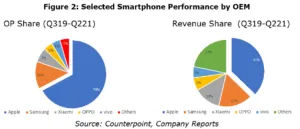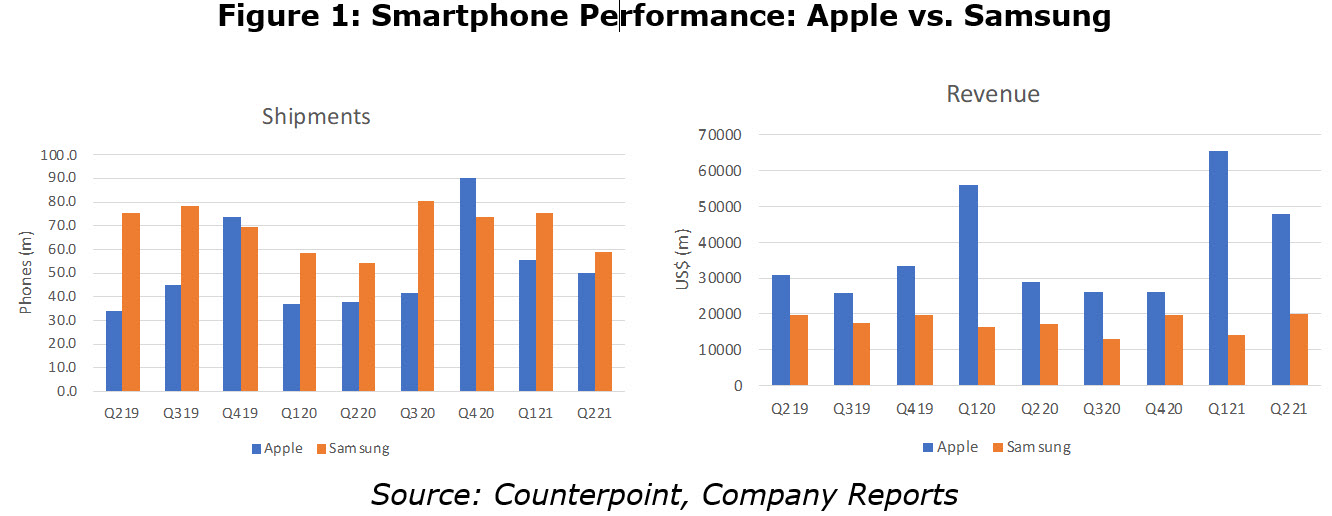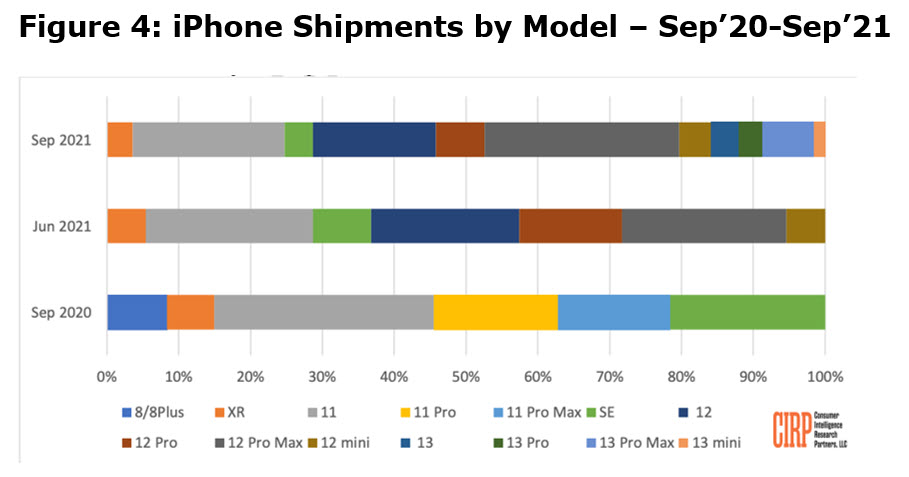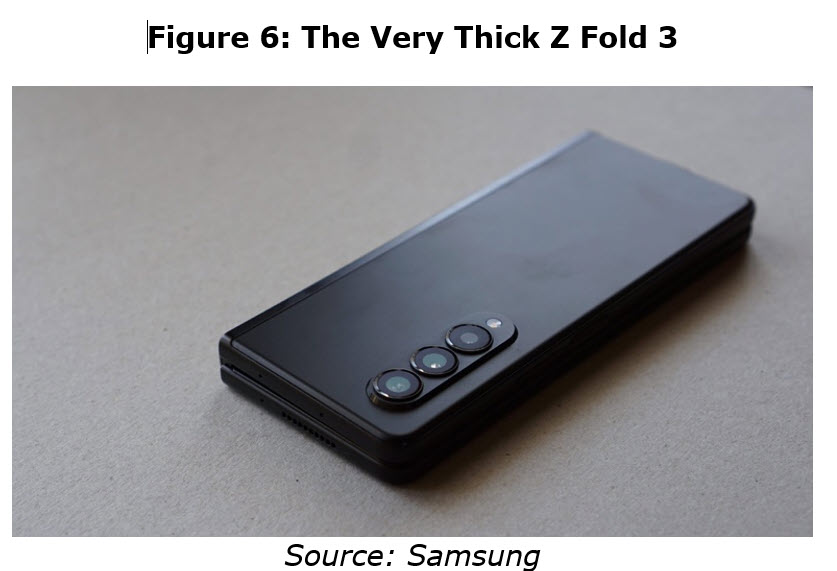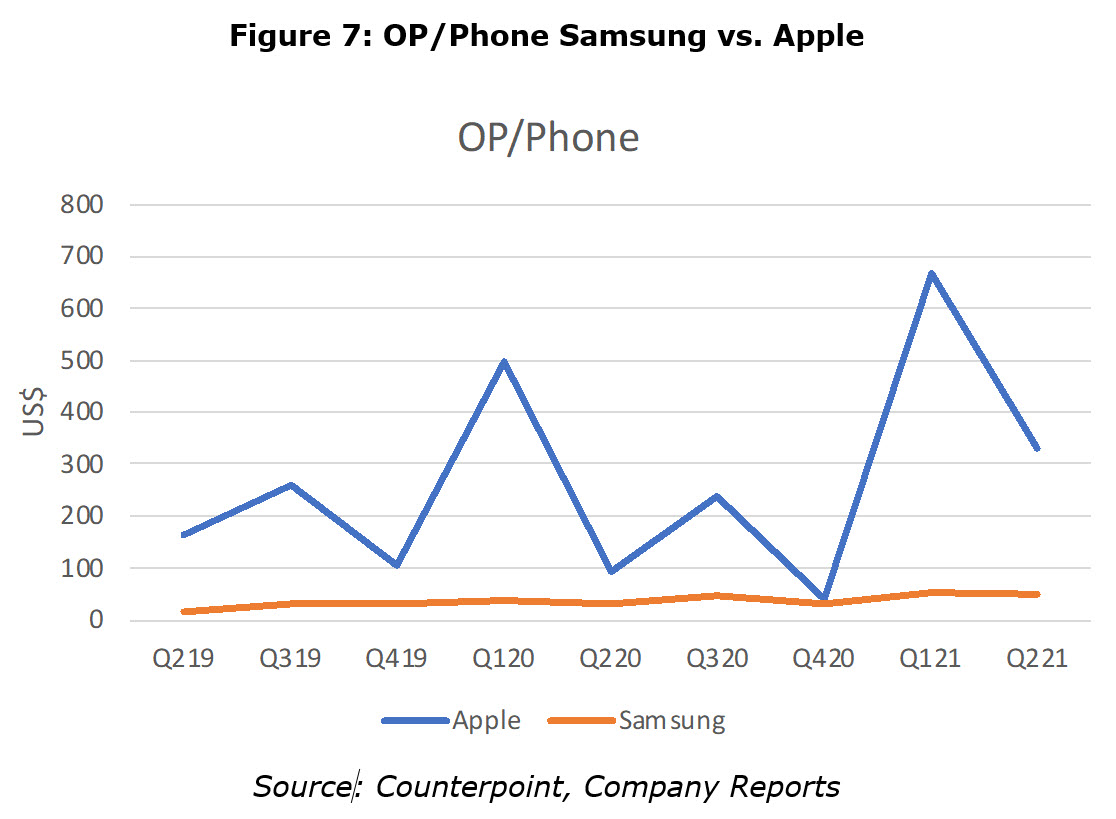Over the past 2 years, Samsung Mobile sold 340m more smartphones, generated $172.7 billion less in revenue and $87.2 billion less in operating profits than Apple’s iPhone. Apple generates 37% of all smartphone revenue and 74% of the industry’s operating profit with a 16% of the shipments.
Recently, TechInsights disassembled the iPhone 13 Pro and estimated the bill of materials (BOM) at $570 vs. $508 for the Galaxy S21+. Both phones are available for purchase unlocked at a similar price of $999. The Galaxy S21 Ultra was estimated to cost less to manufacture than the Galaxy S20 Ultra by 12%-13%, and the 2021 flagship was also cheaper at launch by $200.
Compared to Apple’s iPhone financials, Samsung Mobile’s performance is pathetic in terms of revenue and operating profits.
The problem for Samsung isn’t volume or efficiency since they ship ~20% more smartphones at an average of ~10% less cost. In the Android community, Samsung also operates in the Android ecosystem; Samsung contributes 25% of the shipments, 26% of the revenue and 55% of the operating profit in that ecosystem. The financial differences are explained by the sale of 200m ~$1000 iPhones vs. 50m Galaxy S Series per year. In the US the iPhone average price has been increasing from $800 in Jun’19 to $870 in Sep’21.
In Sep’21, 70% of Apple phones sold in the US were of the iPhone 12 vintage or later. Samsung’s challenge is to get a higher share of the high end phone market, where the majority of the profits come from.
Apple’s Operating Profit (OP) averaged $252 each for 215m iPhones/year, generating $54.1 billion. Samsung sold 50m Galaxy S Series that generated ~$13.8 billion. Samsung’s remaining 225m phones produced ~$7.0 billion in OP. Clearly, Samsung cannot close the gap on OP by selling more phones, although the selling more phones helps SEC’s other divisions – displays, sensors, memory and logic.
Apple reportedly has an installed base of 1b iPhones[1]. In the US, Apple shipped 87.4m iPhones over the last 12 months. Using an average replacement timeframe of 2.5 years, the iPhone installed base calculates to ~200m or 60% of the population. Samsung sold 40m in the same timeframe and only about 2/3rd were the S series.
Samsung Group management has been holding closed door reviews of its mobile program to improve the profitability of the unit. To increase its OP, Samsung should infiltrate Apple’s closed system of the iCloud, iOS and Mac OS, where Apple products interact seamlessly. For example.
–Schedule a meeting on a Mac, it appears on an iPhone and iPad, start driving and an Apple Watch haptically signals when to turn.
In the US, Apple is given a free ride by the carriers. Consumers sign up for two years and get a new iPhone at no additional cost with a trade-in. It’s a no-brainer and since Apple does a re-design every 2-years, their business model is sustained in what could be considered by some to be a restraint of trade. Samsung, and by inference Google, needs to make it a no-brainer to replace an iPhone with an Android smartphone. Samsung would need resources and intelligence to prepare in advance for any iOS changes. That may not be that difficult, since Apple has fallen into the trap of issuing a new release and then following up with corrections and repairs. Samsung would also need to promote the seamless ownership of using a Galaxy smartphone in an Apple environment.
However, even $1,000 flagship smartphones have become commodities, so how can Samsung get an iPhone owner switch to a Galaxy? Today, Samsung has one advantage over Apple – it’s foldable smartphone, well tested and available, while the Apple folding iPhone is not expected until 2023 at the earliest. To make a dent in Apple’s profit dominance, Samsung should be targeting 100m annual foldable sales, not the present 7m to 20m.
But the Z Flip 3 doesn’t solve the problem; it is smaller but thicker and priced the same as an iPhone 13. It has attracted strong early sales but doesn’t present a compelling long term alternative, since using the Flip is the same as using the iPhone. Fundamentally, it has the same screen size, no pen input and a poorer camera. In August of this year, the South Korean tech giant released the much-anticipated Galaxy Z Flip 3. This is the second generation of Samsung’s flip-style folding screen smartphone. Moreover, we are talking about one of the most powerful foldable handsets on the globe. It came with a starting price tag of $1,000. Thus, the Flip 3 was available at a much lower price than most of its rivals.
The main selling point of the phone is the 6.7-inch AMOLED screen that folds in half when the device is shut. The main screen supports 2640 x 1080 pixels (FHD +) resolution and has refresh rates up to 120 Hz. It has a 1.9-inch outer display for notifications, calls, and other information without opening the phone. The price has just been lowered from $1,000 to $850.
The Z Fold 3 is thicker, heavier and 180% more expensive than the iPhone 13 Pro, at ~14mm and 271g, and $1800, held together with a sophisticated hinge. It has an aluminum frame, a glass back that doesn’t attract much fingerprint grease, and a metal hinge protector with the Samsung branding on it, contributing to a high performance product with a luxury price tag.
Samsung has implemented an IPX8 water resistance rating, a major step for foldable phones in narrowing the feature/durability gap to conventional flagship phones. The phone isn’t rated for dust protection and Samsung claims the foldable screen is 80% stronger than before. The Z Fold 3 might be incredibly thick when folded, but it’s also very narrow in this orientation with a TV remote-style form factor when used as a phone, featuring a 25:9 screen ratio for the smartphone screen. It takes two hands to unfold the device, and one hand to fold it back.
The big selling point of the Fold series is the tablet-sized screen in a smartphone form factor. The S Pen improves productivity but the lack of an integrated S Pen slot — or at least without an awkward case — is an impediment. The screen gets sufficiently bright too, so outdoor usage was generally fine, although there’s more glare coming off this screen than the front smartphone display. Faced with these conditions, what is possible to close the OP gap?
The most significant change in strategy is to admit that Apple has won; they own the infrastructure and everyone else is playing 2nd fiddle. Second is to make the Z Series totally compatible with the Apple ecosystem and sell foldables as a differentiator to the iPhone candy bar. Intruding on the Apple ecosystem is no simple matter. It will require software resources by Samsung and Google. It requires a quick strike force that responds to each, and every change made by Apple and the market intelligence to anticipate what’s coming. Moreover, Samsung will likely have to forgo some margin so that the Z Fold competes with the iPhone in price.
A corollary is to deliver OLED notebooks, watches and tablets that also operate smoothly with iOS and Mac OS.
Just as important — Shout Out To The World, “Samsung Consumer Products Operate Transparently With The Apple Ecosystem.”
One data point; Ross Young, DSCC CEO recently converted from an iPhone to the Flip and said the biggest issue was differences in iOS and Android, which required moving all his content over, and sorting out all his passwords. This can’t happen. consumers want a seamless experience.
(BY)
[1] Reuters, indicated that there are over one billion active iPhones across the world. In an interview with the outlet, Apple CEO Tim Cook also revealed that the company now has an installed base of 1.65 billion devices globally.

